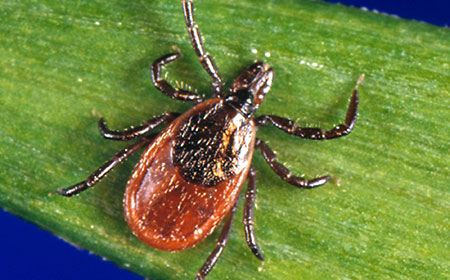Deer Tick
(Ixodes scapularis)

Ixodes scapularis, commonly known as the blacklegged tick or deer tick, is an ectoparasite (external parasite) that gets its nutrients from animal blood. This tick may carry tick-borne diseases such as Anaplasmosis, Babesiosis, Bartonellosis, Borrelia miyamotoi, and Lyme disease.
To identify a female deer tick, look for a reddish-brown body and a black shield on its back. Its mouth parts are long and thin, and there are no festoons present along the abdomen.
The Tick Research Lab of Pennsylvania is able to detect the most common tick-borne diseases in any of these species. Our tick DNA tests are over 99.9% accurate.
Deer Tick Information
Deer Tick Habitat
Deer ticks are present throughout the contiguous 48 states and Alaska. However, they are most prevalent in the large area between the East Coast and Texas. The Great Lakes region is another common location for deer ticks. This species needs plenty of moisture and shade to survive.

The Life of a Deer Tick
The two-year lifespan of a tick generally begins in the spring, when adult ticks lay their eggs. In the last weeks of spring or the first weeks of summer, the eggs hatch. Female tick larvae feed on birds or other small animals during the summer and then wait out the winter. In the spring, they feed again and become nymphs. Between spring and fall, they grow into adults and seek larger hosts such as deer, moose, and bears. After becoming engorged, the adult female will wait until the next spring to lay her eggs. After laying eggs, the tick dies.

Which Deer Ticks Are a Threat?
Humans are usually bitten by nymphs and adults. It is possible to be bitten by larvae, but ticks in their early stages tend to prefer smaller animals. They’re also more difficult to spot than larger ticks, so bites from larvae may go unnoticed. Nymphs may cause more instances of illness than adults do because they are less likely to be discovered while feeding. In the adult life stage, only female ticks transmit disease, this is because male ticks are not known to feed on blood.
Tick bites are a threat throughout the year. While spring and summer are considered peak deer tick seasons, ticks may feed any time the temperature is above 32 degrees Fahrenheit. Some areas of the US have higher tick populations than others.

How Deer Ticks Behave
When a deer tick is seeking a meal, it is said to be “questing.” Contrary to popular belief, ticks cannot jump, and they have no wings. They do, however, climb.
Ticks’ questing behavior varies depending on its region. In the Southern US, deer ticks prefer to stay under leaves. As a result, small animals are at a greater risk of bites than humans are. In the Northern US, ticks will climb plants and extend their legs to catch people or animals.
While adult deer ticks can climb as high as 24 inches from the ground, ticks in the larval and nymph stages are more limited. Nymphs can get as high as twelve inches, and larvae can only travel a fraction of that distance.

Which Animals Attract Deer Ticks?
Deer ticks will not feed on every animal, but their menu includes hundreds of species. The top carriers of deer ticks are bovines, moose, deer, dogs, chipmunks, shrews, mice, reptiles, and birds. Of all the animals on that list, mice, shrews, chipmunks, and birds may be infected with Lyme disease and will transmit it to a biting tick. Humans can also contract Lyme disease.


